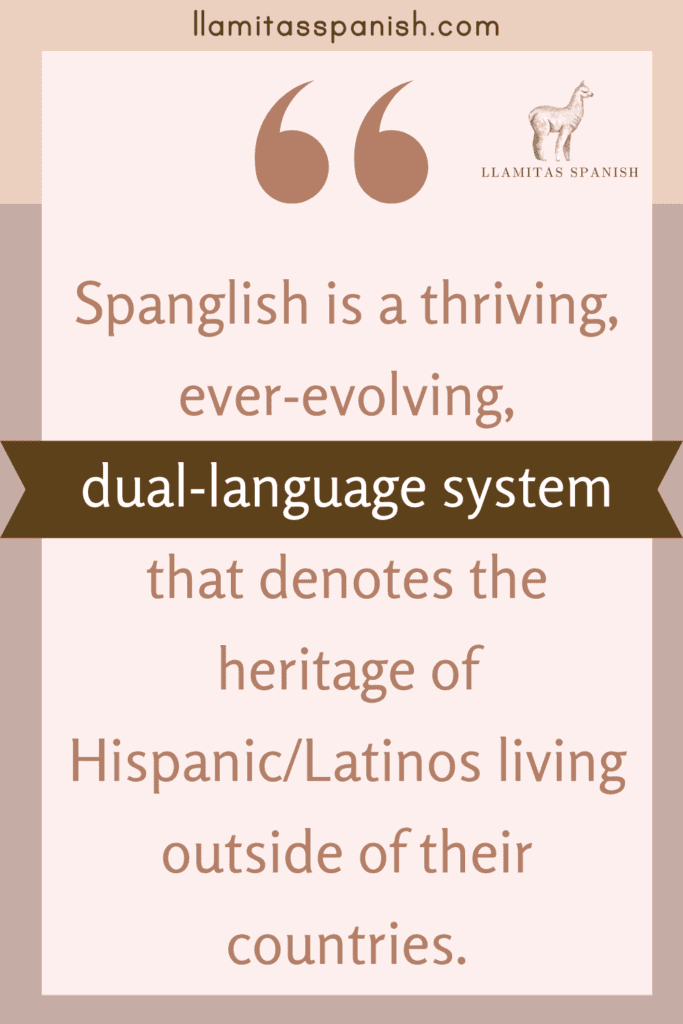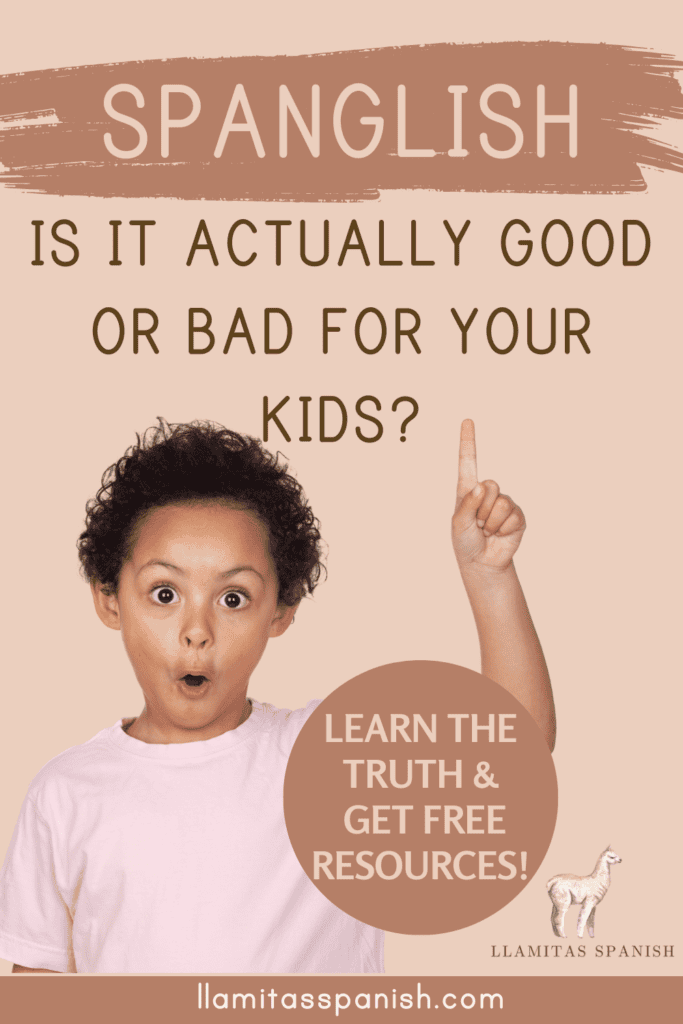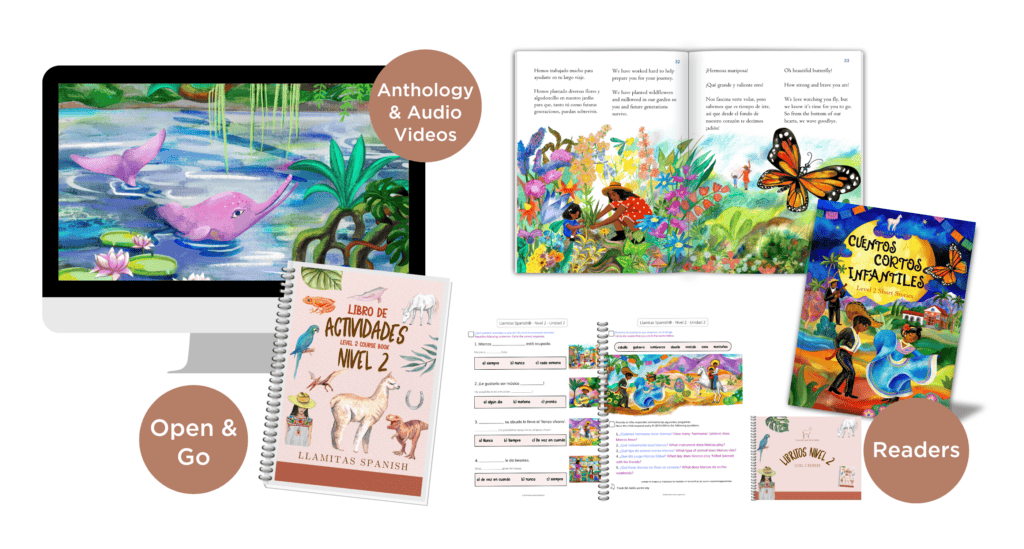In this post: Learn about Spanglish! Is it a real language, a dialect or just word play? Is it OK for your child to speak it?
In any community where two languages converge, new ways of speaking emerge too. This is due to the evolving intermixing of the two languages.
In the U.S., particularly in regions where there are large immigrant Spanish-speaking populations, Spanglish has evolved as a linguistic phenomenon.

Some estimates suggest that Spanglish is spoken among 35 to 40 million people across the United States. This represents a majority of the 62 million Latinos who reside in the U.S.
As more and more families become bilingual, Spanglish is also more widely spoken in families, homes, and communities.
If you want to raise a bilingual family in the United States, and provide your children with the advantages of bilingualism – start by grabbing our eBook: Learn Spanish en casa.
It’s full of Spanish resources, and a complete step-by-step bilingual parenting plan to help you get started, and stay consistent!

Table of Contents
A Definition
Spanglish is a system of mixing Spanish and English together that has evolved in many bilingual communities where both languages are spoken interchangeably.
It has become increasingly popular in cities with large Hispanic/Latino populations, as well as in popular music and song lyrics.
Spanglish is commonly spoken in places like Southern California, Miami, New York, and Puerto Rico. However, you will hear it any city, community, or home in which Spanish and English are co-existing.
Is Spanglish a Language?
Spanglish does not qualify as a language, because it actually combines two existing languages to create a hybrid linguistic system.
It also has no written grammatical rules and no set vocabulary, and varies widely from region to region.
Spanglish is also not considered a dialect. It is not an evolution of a language due to geographical separation (for example, Jamaican patois as a derivative of English). Instead, Spanglish is a hybrid system that combines two distinct languages.
Spanglish is a thriving, ever-evolving, dual-language system that denotes the heritage of Hispanic/Latinos living outside of their countries.
Spanglish is a source of pride in Latino identity, and is used in literature by Chicano, Nuyorican, and other Latino poets, playwrights, and novelists to express the experience of bilingualism.
In fact, terms such as Chicano (which refers to Mexican-Americans) and Nuyorican (referring to Puerto Ricans born in New York) are Spanglish terms.
While words like these are commonly understood across the U.S., some terms may be much more regionalized.
For example, the word Yuma as a reference to people from the U.S. is used specifically by Cuban immigrants and Cuban-Americans in the areas of New York City and Miami. This term is quite possibly unheard-of in other regions with much smaller Cuban populations.

Is it OK to Speak Spanglish?
Not only is it ok to speak Spanglish, it’s actually a lot of fun to speak Spanglish!
Spanglish can help strengthen your child’s memory center, according to noted American psychologist Dr. Donald D. Hoffman. It is essentially a type of code-switching.
Dr. Hoffman, an expert in the study of human perception, concluded that code-switching between speakers of two different languages actually serves as a valuable linguistic exercise. It activates and strengthens the brain’s memory centers, leading to improved cognitive abilities.
Related post: Code-switching: Is it Good or Bad?
There are definitely occasions, however, when it might not be appropriate to speak Spanglish. While it’s perfectly fine to speak Spanglish among a bilingual group, using Spanglish among monolingual speakers may cause confusion and misunderstandings.
Spanglish is considered a type of bilingual slang, so it may not be appropriate to use when making formal presentations. It can also be seen as “casual” and therefore not always appropriate if you wish to convey respect.
Spanglish spoken in the U.S. also does not usually translate to communities you may encounter when traveling to Latin America or Spain. So it’s best to stick to basic Spanish in those circumstances.
Spanglish may also not go over well in English-speaking communities where there are very few Spanish speakers. So it’s always about context.
When in doubt, opt to speak either “pure” English or Spanish until you are certain that the people around you can understand Spanglish.
Does Spanglish Prevent Your Child From Learning Real Spanish?
In today’s digital, global landscape, Spanglish is probably spoken in more Latino/Hispanic households in the U.S. than either “pure” English or “pure” Spanish. A vast number of children are actually growing up with Spanglish as their first “language.”
The secret to becoming fluent in Spanglish is having an excellent understanding and command of both languages, and learning how to distinguish between them.
Related Post: Academic Elementary Spanish Curriculum

Any confusion about when it’s ok to use Spanglish can be cleared up with simple discussion. Never make a child feel bad for slipping into Spanglish. Always make this a fun thing you can laugh at and easily correct.
Sometimes kids switch naturally between their two languages because they can’t yet fully express themselves in a single language. Or they simply forget a particular word in one language and replace it with the translation they do know. This happens particularly in the case of kids who are growing up bilingual from birth.
Using Spanglish allows them to express their ideas without having to hunt for the right word in the heat of the moment.
It’s OK to encourage your children to use Spanglish. Just remind them that Spanglish is actually a mix of their two languages. You should also make sure they can identify which language is which.
One easy strategy is to provide specific circumstances for speaking only Spanish (en casa de los Abuelos), and/or only English (at school or day care). This will help them to distinguish between the three ways of speaking.
Appropriate Times to Speak It
It’s definitely considered OK to speak Spanglish:
- When talking to a group that understands both languages
- When the subject requires the use of certain words in a specific language
- When you’re directly quoting something that someone said
- When the idea is easier to understand by using both languages
- When you want to emphasize a cultural point
- When identifying with a specific group such as Nuyoricans
- When referencing something specific such as titles
- When using specific local or cultural expressions
Sometimes, people will switch into Spanglish without even being conscious of it! This happens especially when sharing personal information or recalling personal memories. The longer a person has been bilingual, the more comfortable they typically feel speaking Spanglish.
Does Spanglish have Rules?
Spanglish is not a proper language and has no grammatical rules. This means speakers can get very creative with how they mix the two languages. Whether within a single word, sentence, or paragraph to express a unique idea or concept.
But even though there are no rules to Spanglish, there are some typical ways that code-switching between languages commonly occurs:
Sometimes, you can turn a monolingual statement into a Spanglish statement. This is done by inserting some words from one language into phrases in the other language, such as:
- No vamos a salir because it’s raining.
- Ya terminé mi homework.
You can also modify actual words, adding an ending or other lexical morpheme, such as:
- Voy a chequear mi email.
- Estábamos chateando
Spanglish can also include changing the pronunciation of words, for example:
- Fuimos a comer donas (donuts)
- Ella compró pinabora (peanut butter)
You can even mix words within an individual clause or sentence, as in these examples:
- I’m tired, vámonos.
- Do you see it? Está ahí mismo.
You can also use an interjection, sentence filler, or “tag” as a way to mix in the other language, such as:
- Lo vamos a hacer así, okay?
- Mira, that’s where my cousin lives!
Academically Robust Spanish Curriculum
To enhance your child’s Spanish language with an authentic curriculum, check out our award-winning Llamitas Spanish® curriculum.
With sequential levels, we support your child throughout their Preschool and Elementary grades. Levels include Spanish language arts, math, music, sciences, geography, cultural studies, and more!

The most important thing to remember when it comes to learning any language is to make it fun. Like life itself, language is a constantly evolving thing that humans can have endless fun playing with. The secret to keeping it fun is to release all pressure and expectation.
Have fun mixing up English and Spanish words to make cute bilingual sentences. Laugh at yourselves when they sound silly.
Play around with different ways to say the same things and have fun with it. Use these games to solidify in your child’s mind when they are using Spanish, English, and Spanglish.
Finally, remember to express gratitude for the privilege of having so many ways to express yourselves!

